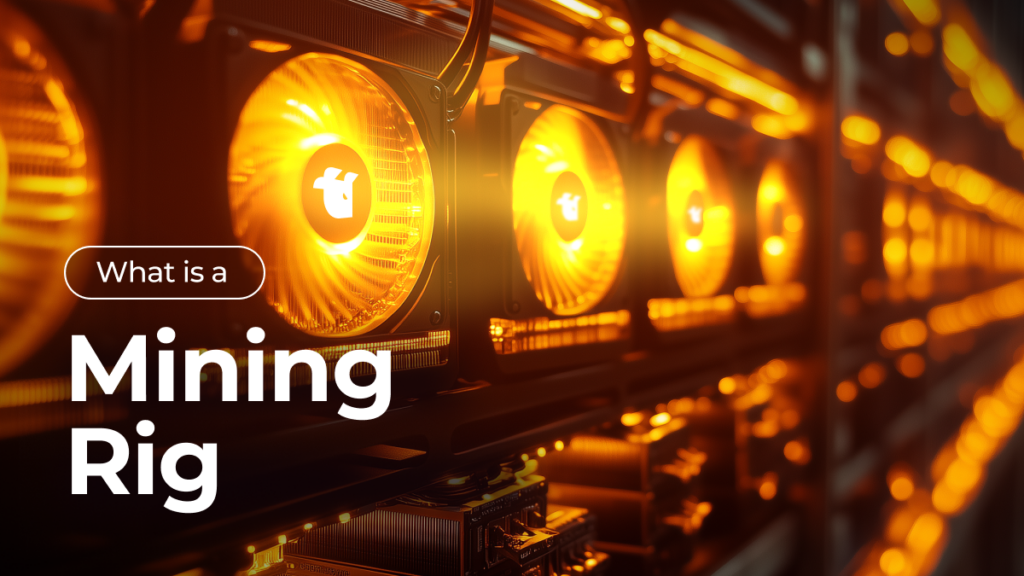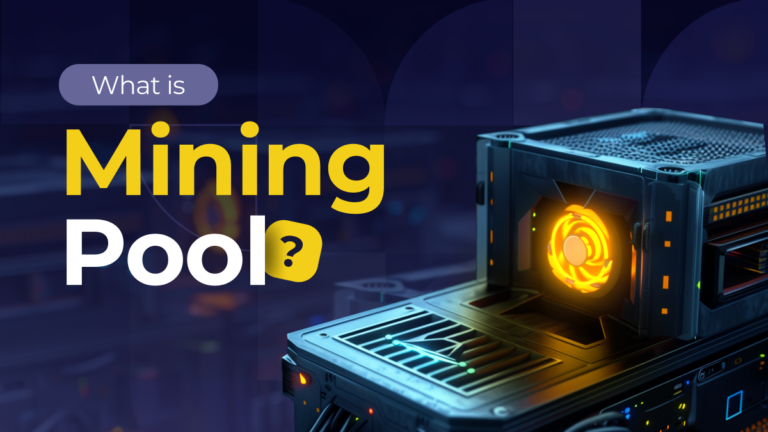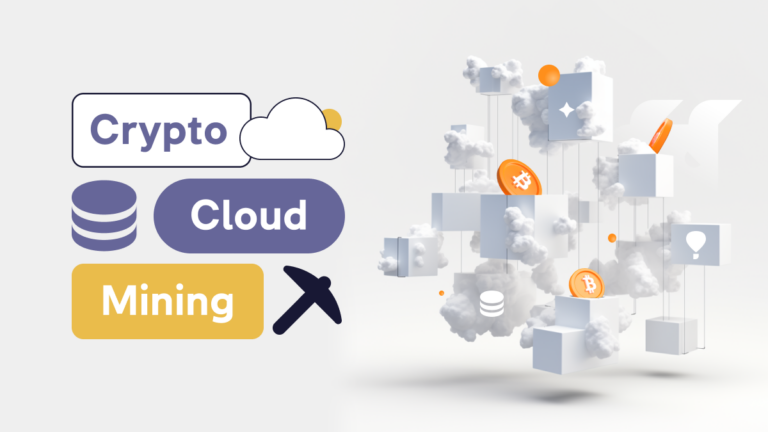What is a Crypto Mining Rig and How to Build It?

Content
Mining farms have become synonymous with big profits and technical innovation in cryptocurrencies. These high-tech data centers are not just rows of computers but complex systems that require thoughtful consideration of cooling, energy costs, and software. In this article, we’ll examine what is a mining rig, how it works, how to set up a crypto mining rig, and what factors affect its efficiency.
What is a Crypto Mining Rig?
A mining farm is a specialized center where cryptocurrencies such as Bitcoin (BTC) and Ethereum (ETH) are mined using powerful computers. These farms are a collection of equipment, including bitcoin mining rigs, cooling, and power supply systems. The main purpose of mining farms is to provide computing power to solve complex mathematical problems that validate transactions in the blockchain and create new blocks. Mining requires significant energy inputs and optimal resource management to maximize efficiency and profitability.
Modern mining farms are often located in regions with low energy costs and cold climates, which helps to reduce equipment cooling costs. Farms range from small home installations to large industrial complexes with thousands of miners. Depending on the scale and technology used, these farms can generate significant revenues but require significant investment and ongoing maintenance. The development of mining farms plays a key role in supporting the security and decentralization of the blockchain network, ensuring their stable operation.
How Does a Mining Rig Work?
A mining farm uses powerful computers specially designed to solve complex mathematical problems called hash. These tasks are necessary to validate transactions on the blockchain and create new blocks. Each computer or miner connected to the farm calculates the correct solution for the next block. When a miner finds the right solution, it adds the block to the blockchain, and its owner is rewarded with cryptocurrency. To increase processing power, mining farms utilize multiple miners connected to a single network to find solutions faster and increase the chances of getting rewarded.
Mining farms require significant resources to operate. One key aspect is power consumption, as miners consume large amounts of electricity to perform calculations. To ensure stable operation of the farm, thoughtful cooling is necessary to prevent the equipment from overheating. Modern farms often use water cooling systems or are located in regions with cold climates to reduce energy costs. Farm management includes monitoring equipment performance, software updates, and regular maintenance to maximize efficiency and long-term profitability.
Types of Mining Rig
CPU
CPU (central processing unit) mining farms use central processing units to mine cryptocurrencies. This mining method was popular in the early stages of cryptocurrencies, such as Bitcoin. CPU farms consist of regular computers or servers equipped with powerful processors. Although this type of mining is easy to set up and accessible to everyone, it is already inefficient for most modern cryptocurrencies due to the low processing power of CPUs compared to other methods.
GPU
GPU (Graphics Processing Unit) mining farms utilize graphics processors that are far superior to CPUs in terms of power in the computational tasks involved in mining. Such farms have multiple graphics cards working in parallel for high performance. GPU mining is particularly effective for mining cryptocurrencies such as Ethereum, where the algorithms require a lot of computing power. Video cards offer a good price/performance ratio and flexibility as they can be reconfigured to mine different cryptocurrencies.
FPGA
FPGA (Field Programmable Gate Array) mining farms use programmable logic integrated circuits that can be customized to perform specific mining tasks. FPGA devices offer better performance than CPUs and GPUs but require more complex customization and programming. The advantage of FPGAs is their power efficiency and the ability to be reprogrammed for different algorithms. This makes them attractive to miners looking for a balance between performance and flexibility.
ASIC
ASIC (Application-Specific Integrated Circuit) mining farms use specialized integrated circuits designed solely to perform mining tasks. ASIC devices have the highest performance and energy efficiency of any type of mining equipment. They are optimized for specific algorithms, such as SHA-256 for Bitcoin, making them unmatched in mining speed. However, ASIC devices cannot be reconfigured for other algorithms, and bitcoin mining rig cost and maintenance complexity can be an obstacle for some miners.
Key Components of a Mining Rig
Bitcoin mining rig has several key components that ensure efficient operation and maximum performance. All farm elements must be properly selected and configured to ensure stability and long-term profitability. The key components can be divided into several categories, each with its important role:
- Equipment
This includes everything described above: CPU/GPU/FPGA/ASIC.
- Motherboard
The motherboard should support multiple graphics cards (for GPU farms) and have enough PCIe slots to connect all the necessary hardware. A reliable motherboard ensures stable operation and optimal performance of the entire farm.
- Power supplies
Power supplies for crypto mining rigs should be high-power (usually 1000W and higher) to ensure stable operation of all components.
At the same time, they should be reliable and efficient in reducing power consumption and heat dissipation.
- Cooling
Cooling a cryptocurrency mining rig involves using fans and cooling systems to keep the equipment at an optimal temperature and water cooling systems to dissipate heat more efficiently; locating farms in colder climates also helps reduce cooling costs.
In addition, the case and frame of the mining farm must be sturdy and roomy to accommodate all the components while providing good ventilation and easy access for maintenance. Software, mining programs, and monitoring systems are important for tracking performance. You should also remember a stable and high-speed internet connection, which is necessary to transfer data to the blockchain network, and reliable wiring for stable farm operation. These components ensure the efficient operation of the farm, maximize performance, and minimize the risks of overheating and downtime.
*To safely store cryptocurrency mined, every mining farm should use a secure crypto wallet that protects assets from cyber threats and provides quick access to funds.
Mining rig setup. Source: AdobeStock / Photocreo Bednarek
Factors to Consider When Selecting a Mining Hardware
When choosing equipment for a mining farm, it is important to consider several key factors that affect its efficiency and profitability. Performance (hash rate) and energy efficiency determine how fast and cost-effective the equipment will be at completing tasks. The initial investment cost should be balanced against the expected payback, while equipment reliability and durability will help avoid frequent breakdowns. An efficient cooling system prevents overheating and extends the life of the equipment. Compatibility with mining and monitoring software makes it easy to manage your farm. The size and scalability of the equipment are essential for integration into existing infrastructure and future expansion. Accessibility and availability of technical support from the manufacturer ensures prompt problem resolution. Noise levels and environmental impact also need to be considered when selecting a location for the farm. Finally, the relevance of the technology and the ability to update it play an important role, as mining equipment becomes obsolete quickly.
How to Build a Crypto Mining Rig?
A lot of people ask how to make a crypto mining rig. Building a mining rig starts with planning and calculations: decide which cryptocurrencies you want to mine and select the right equipment. Calculate the initial costs, power consumption, and expected profitability. Purchase all necessary components, including miners (GPU, ASIC, or other), motherboards, power supplies, cooling systems, and enclosures. Install the motherboard, CPU, RAM, and GPU into the case, connect the power supplies, and make sure all cables are securely connected. Set up the cooling system with fans or water cooling to ensure efficient heat dissipation.
How to Set up a Mining Rig?
Once you build crypto mining rig, you need to connect and configure the software. Install the operating system (e.g., Windows, Hive OS or RaveOS) and the mining software (CGMiner, BFGMiner). Connect the farm to the power grid and the internet, start it up, and test the operation of all components. Optimize the mining parameters for maximum efficiency, overclock the GPU, and adjust the voltage. Regularly check the status of your hardware and update your software. Follow preventive maintenance to avoid downtime and extend the life of components.
Legal and Ethical Considerations
Different countries have different laws and regulations regarding cryptocurrency mining. Check local laws to ensure your activity is legal and complies with regulatory requirements, including licensing and taxation.
Ethical considerations include electricity consumption and environmental impact. Mining requires significant energy resources, which can lead to an increased carbon footprint. Strive to utilize renewable energy sources and adopt energy-efficient technologies. Consider social aspects, such as the impact on local power grids and communities.
Conclusion
Let’s refresh your memory. A mining farm is a system consisting of several combined devices connected to a blockchain network to mine cryptocurrencies. They secure the network and reward participants for their contribution to transaction processing. However, setting up and maintaining a mining farm requires significant resources and technical expertise. The volatility of cryptocurrency markets significantly affects the profitability of mining farms, requiring miners to monitor prices and adapt to changes constantly. Prospective miners should consider everything from equipment selection to assessing potential risks and returns to maximize their investment.
FAQ
To create a DIY mining rig, you must buy powerful video cards, specialized processors (ASICs), motherboards, power supplies, and a cooling system. Stable internet and mining software are also important.
The cost of a mining farm can vary from a few thousand to tens of thousands of dollars, depending on the equipment's power and the project's scale.
The profitability of a mining farm depends on the current crypto prices, electricity and equipment costs, and the level of complexity of mining. During periods of rising cryptocurrency prices, profits can be high, but there are also risks associated with market volatility.












